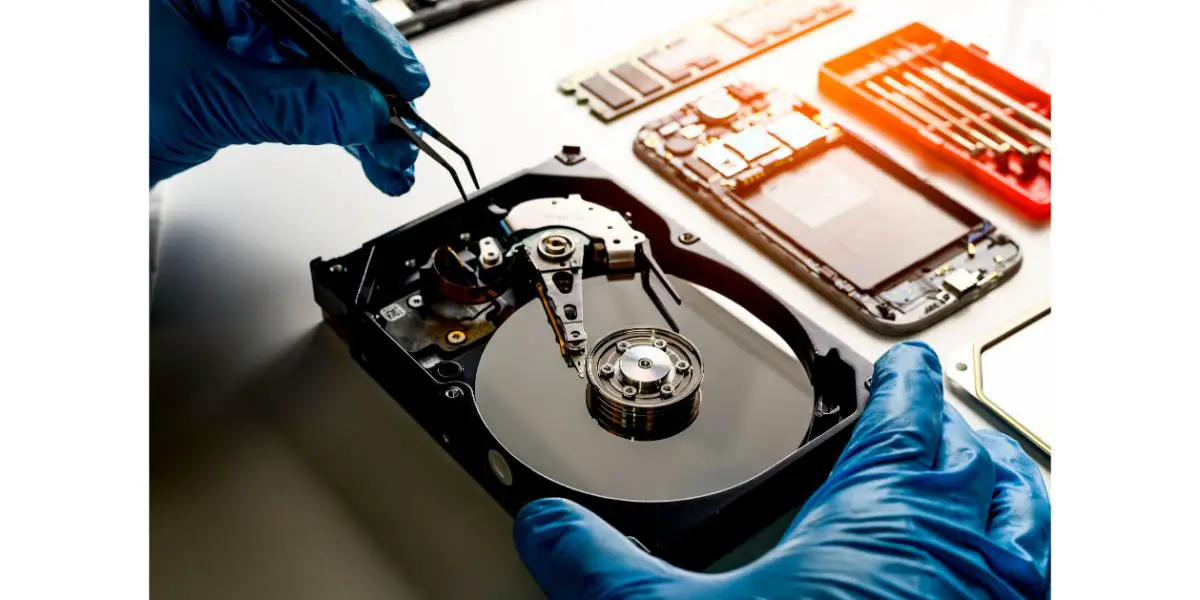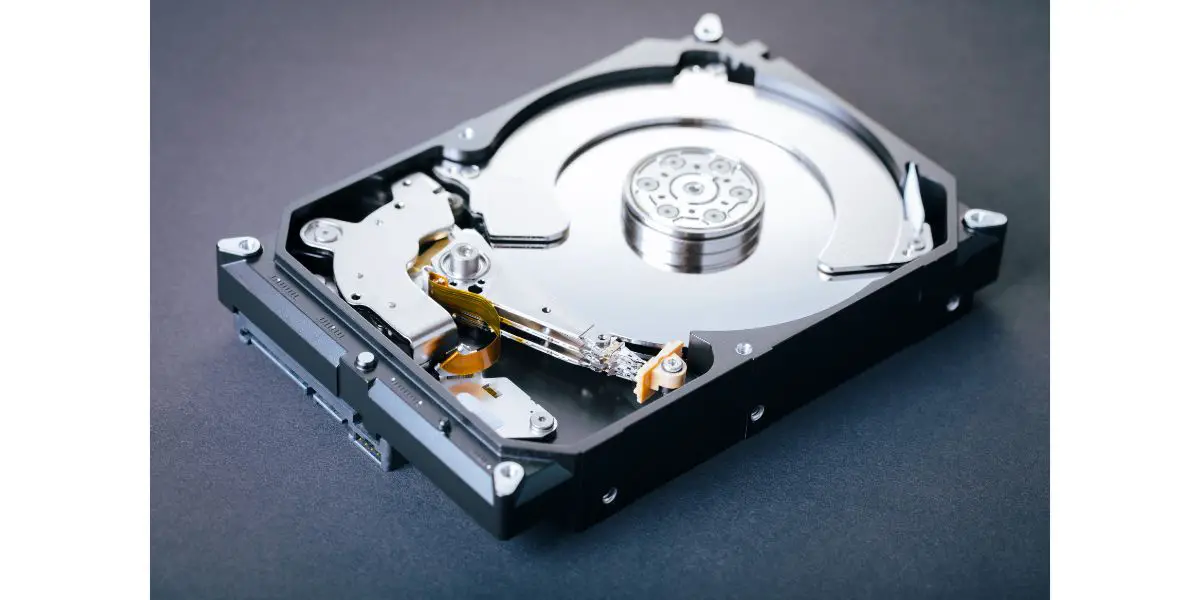Disclaimer: This post may contain affiliate links, meaning we get a small commission if you make a purchase through our links, at no cost to you. For more information, please visit our Disclaimer Page.
Data loss is not a rare issue and can occur for a variety of reasons. Thankfully, it can be solved with the help of professionals or special software designed for data recovery. Here’s how it works.
Hard drive recovery restores the lost data except for the files that were overwritten. In most cases, it is possible to use data recovery software. If physical damage is involved, service providers will restore your data by creating an image of your hard drive and extracting the files.
In this article, you will find a comprehensive guide to hard drive recovery. There are a few approaches, and the cause of data loss will determine which one is most suitable. Therefore, we will first go over potential reasons for data loss and then describe how you should proceed in each case, with a detailed explanation of each method.
Table of Contents
What Is Hard Drive Recovery?
Let’s first discuss what hard drive recovery is and what it can and can’t do.
Hard drive recovery allows you to get back the data you lost due to whatever reason. It can be a simple mistake of deleting a file you actually need or a major problem like spilling liquid and damaging the hard drive.
Generally speaking, recovery methods can be of two kinds: using data recovery software or involving physical repair.
The first technique is the most widely used and is relatively easy to implement. Software recovery is useful when the file is removed from the bin or the structure is corrupted. We’ll go over other typical cases later in the article to give you more specific details.
The second approach is used when the hard drive is physically damaged. Here, performing the recovery yourself is very risky if you don’t have relevant experience, so it is best to seek professional help.
As you can see, hard drive recovery can be more or less complicated depending on what caused the data loss. However, there are also cases where it can’t do much.
If the hard drive is severely damaged, it may be impossible to restore any data from it. If you experience hardware failure, you can find out your chances through hard drive evaluation by a service provider. We will cover this step in more detail later on.
Another case is overwritten data. When the files on your hard drive get deleted or corrupted, they don’t seize to exist even if you can’t access them. Such data sits in the storage until it gets overwritten by something else.
This is the chance we use for data recovery. Until it is replaced with new data, it can be found on the drive and brought back to you. However, once the files are overwritten, it is virtually impossible to restore them.
4 Possible Reasons for Data Loss
Now that we’ve covered the basics, let’s dive into details about what can cause data loss. The methods you can use to get the data back and whether it will be at all possible depends on what issue occurred with your files.
1. Deleted Files
This is one of the most typical reasons for data loss. It’s a very human thing to delete an important file by accident. Sometimes, it has to do with entire folders of important data which is not backed up.
As mentioned, files don’t just disappear after you move them to the bin and clear it. That is simply how storage works: it doesn’t erase the files, just overwrites them when it needs to. By deleting something, you signal that particular data is no longer needed, and its slot can be used for other things.
The system deletes information about where the files are stored (each OS does that in its own way), which is why it cannot be directly accessed. Data recovery software can quickly fix the issue.
2. Blackout and Power Outage
Despite modern computers having a decent degree of protection against such instances, they still happen from time to time. A power outage or similar emergency can deal logical damage to the system, causing data loss.
Similarly to the previous case, logical damage doesn’t lead to data disappearing completely. It messes with the file structure, starting with one error of writing the wrong data to the wrong place and ruining–you guessed it–the structural logic of file organization.
As a result, the system can’t read through this chaos, and you lose access to your data. The good news is that the structure can typically be restored with the help of data recovery software. It traces the files back and organizes them in the correct order, getting things back to normal.
3. File System Formatting
Formatting is typically used to organize your storage. It is usually performed before initial use to prepare the hard drive for storing new files. This means that if you start file system formatting, accidentally or not, it will remove all your data.
Thankfully, this doesn’t mean your files aren’t recoverable. The system creates new file structures in the process, not necessarily overwriting the existing ones, which is good news. If you remember, we’ve mentioned that only overwritten data can’t be restored. The rest is still somewhere on our hard drive and can be brought back.
4. Physical Damage
Physical damage is the most severe case of them all. This includes:
- Spilling liquids on your laptop or PC.
- Overheating that leads to the hard drive getting partially burned.
- Dropping your device.
- Any other accident that results in physical damage.
Whether you will recover your data and how much of it can be saved depends on how badly your hard drive is damaged. In most cases, experienced specialists can extract the most important files, but sometimes, even that can be impossible.
To access your files, you will need to take the hard drive to a professional team to perform an evaluation. It should be done very carefully in order not to deal with additional damage. The results will determine what can be done and how much data can be extracted.
After evaluation, you will get a quote and will decide whether you want to proceed with data recovery. With physical damage, all manipulations should be left to professionals. Otherwise, you risk losing the files altogether.
Hard Drive Evaluation
Let’s now discuss the specific steps and approaches to hard drive recovery. Hard drive evaluation is the ideal place to start. It assists in determining the reasons for data loss and the measures required to restore your files.
Evaluation Process Explained
If you are certain about what happened to your files (for instance, you accidentally deleted them), evaluation can be skipped, but in every other case, it is essential to determine the right course of action.
It is not recommended to make any attempts at hard drive recovery before examining it and revealing all existing issues. It is also best to let specialists deal with the process for you.
With that said, let’s get a general idea of how it works.
Evaluation starts with diagnostics. There are special tools for running this kind of test that can check for potential issues, instability, and data available for extraction. Here are examples of what the diagnostics look for:
- SMART (Self-Monitoring, Analysis, and Reporting Technology) is a test that looks for hardware failures. It is not entirely reliable, as sometimes the results may miss an existing issue, especially if it has to do with accidentally dealt damage.
- As SMART can’t detect an electronic failure, it is searched for separately by the tools.
- Last, the diagnostics test looks for logical failure that coils occur because of physical damage.
If all tests are done and passed successfully, it is time to build a head map. Heads determine the readability of files and how they are written. Building a head map will show to what degree the system was damaged and whether it is possible to create an image of the hard drive.
These two steps will give enough information to build a plan for data recovery. At this point, a service provider will suggest a solution and give you a quote.
Addressing the Issue
Remember that any manipulations with the storage can deal irreversible damage to your data and make a recovery impossible.
Therefore, your best bet would be to seek professional help and let specialists perform the evaluation for you. Once they know what exactly went wrong, they can help you resolve the issue or give advice on how to move forward.
Along with your hard drive, you will need to provide the specialists with all relevant information regarding your case. The more you can tell about your data loss emergency, the better.
Typically, you will be offered to fill out a form with everything your service provider needs to know. Questions may vary, but here are the most crucial points you’ll likely have to cover:
- Information about your hard drive. You will need to estimate the size of your data and provide specialists with the overall storage capacity of your hard drive.
- Describe your data loss emergency. If you know exactly what happened, for instance, the hard drive was physically damaged, explain the accident. If any further manipulations with storage occurred, tell about them, too. In case you don’t know what went wrong, provide the team with all relevant symptoms, such as strange noise.
- Talk about the data on your hard drive. Determine what data is most crucial to you and describe it to the team with the names of files, paths, etc. It is not always possible to recover everything, so be precise about what should be prioritized and restored first.
Hard Drive Recovery Software
In most cases (pretty much everything that doesn’t involve physical damage), data recovery software can solve your problems. Here’s how they work, how to use them, and how to find the best software option.
How Hard Drive Recovery Software Works
As mentioned, your lost or deleted data exists on the hard drive until it gets overwritten. You can’t get access to it as the system makes it sort of invisible, partially removing the information on how to find the files.
Data recovery software looks in spaces you can’t reach. When the system marks a slot with deleted data as available for new files, the old files get an ‘unused’ status, signaling that they are no longer needed.
The hard drive recovery software will scan your storage for files of this type and give you a preview of what it managed to dig up. You can look for the data you need and get it back with the help of the same software.
An important thing to keep in mind is that files can get overwritten very quickly. Sometimes, you won’t even know changes are made to your storage, but any modification can lead to you losing some of the data that needs to be recovered.
For instance, if you want to install data recovery software to get lost files back, there is a high chance its data will overwrite what you’re aiming to restore. So, it is always best to have the software set up on your PC beforehand and use it as soon as you realize some of your data is gone.
With the general principal explained, let’s now look at how the hard drive recovery software manages to find your lost data and bring it back.
Analyzing Data
The first method data recovery software can use is to look for the remaining information about your lost data. While the information on where to find it is often inaccessible, other parameters, such as name or size, can still be reached. The said data is later used to restore deleted files.
Analyzing File Types
A less reliable but still working method when not much data is available is looking for patterns that detect specific file types. Hard drive recovery software scans the 0s and 1s, looking for keys that may show a beginning and end of a file depending on its type, which can help find your lost data. The rest of the information, however, will not be recovered.
Choosing the Software
There is a great variety of options for data recovery software available, and most of them show great performance.
These options can be generally divided into two categories: free and non-free. Some products have both free and paid options for you to choose from. EaseUS Data Recovery Wizard and Stellar Data Recovery are among the most popular choices in both categories.
If you regularly back up the most critical files and don’t find yourself at high risk of irreversibly losing something of utmost importance, it makes sense to settle for a free option. After all, data recovery software can be quite costly.
However, paid products usually offer a wider range of opportunities, perform better, and get constant support from the devs. So, if you want to ensure the safety of your files and eliminate any chance of losing them due to an unexpected error, get paid software.
Physical Repair
Physical repair is a complicated process, especially if your hard drive experiences severe damage. It has to be performed in a clean space and with every precaution to prevent data from getting lost forever.
While we don’t recommend doing this on your own, it wouldn’t hurt to explain how professionals approach the issue. Here’s a brief overview of the step involved in the process.
Creating an Image
The first step is also the most crucial one as it determines our overall success. The better image we manage to get, the more accuracy we can achieve when extracting files.
During an evaluation, the team will determine whether your hard drive is stable enough for this process. Sometimes, its state doesn’t allow to create an image safely, so the specialists will have to work with proper configurations in order not to lose the data which is still available for extraction.
The tools previously used to run diagnostics tests are also involved in creating an image. It is a rare case that all data can be copied, which is why the service provider will typically request instructions on which files should be prioritized.
Once a full or partial image is created, specialists can work on recovering the data tree and looking for files that can be extracted.
Extracting the Files
When the image is safely made, and the team finds the files you marked as the most important ones, they will be extracted. It is a simple process of transferring the recovered files to a storage device that you can later use. The more files are available for extraction, the longer this process is likely to take.
Getting Results
Once the extraction is complete, you will again receive a preview of what the service provider managed to dig up. Check for the files that you asked to be retrieved in the first place and make sure nothing is missing. If anything’s wrong, notify the team so they can try once again if that is possible.
When the satisfactory result is achieved, restored data will be delivered to you on a new and safe storage device.
Backing Up Your Data
Now that we’ve discussed everything there is to know about hard drive recovery, we understand a few things. First, a variety of accidents no one can be safe from can cause your data to get damaged or vanish. And second, recovering the lost data can be a very complicated process. In some cases, it is not possible at all.
That leaves us with the most simple solution there is: to back your data up. Always get copies of the most crucial files and folders and save them on separate storage devices. It is the best way to prevent important data from disappearing.
There is no guarantee that a spilled drink or a sudden blackout won’t cause failure in your hard drive. Once it happens, there is no guarantee you will be able to get back the data you need. Think ahead and protect yourself from unfortunate accidents. If they happen, though, now you know what to do!
Conclusion
How hard drive recovery is performed depends on why the data was initially lost. If it was accidentally deleted or corrupted, data recovery software could find it hidden on your drive and restore the files. If there is a hardware failure, it is essential to reach out to qualified service providers for physical repair.



